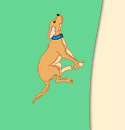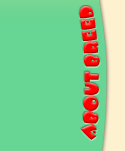Standard of breed Cadebou
FEDERATION CYNOLOGIQUE INTERNATIONALE
SECRETARIAT GENERAL; 13, Place Albert l - B 6530 THUIN (Belg.)
FCI-Standard N 249/13.06.1997/GB
Mallorca Mastiff
(Perro Dogo Mallorquin/Ca de bou)
Translation: C.Seidler
A country of origin: Spain
Date of the publication of the original valid standard: 11.12.1996
Utilization: watch and guard dog.
Classification F.C.I:
Group 2 Pinscher and Schnauzer-Molossoid breeds-Swiss Mountain Cattle Dogs and other breeds.
Section 2.1 Molossian, Mastiff type.
Without working trial.
GENERAL APPEARANCE
A typical Molossian of somewhat elongated build, strong and powerful, of medium size. The difference between the sexes is apparent in the head, whose circumference is definitely greater in males than in females.
BEHAVIOUR / TEMPERAMENT
Quiet by nature, he can under some circumstances be courageous and brave. He is at ease with people, faithful and devoted to his master. As a watch and guard dog, he is unsurpassed. In quiet situations, he is trusting and self assured. When roused, his expression is piercing.
HEAD
Strong and massive.
CRANIAL REGION
Skull: Large, broad and almost square. Its circumference, specially in males, is greater than the chest measurement taken at the withers. Forehead is broad and flat. Frontal furrow well defined. Seen from the front, due to the shape of the skull, back of skull is not visible. Upper planes of skull and muzzle are almost parallel, lightly converging.
Stop: Seen from side, strongly defined and protruding; seen from front, only noticeable because the eyebrow arches form a definite frontal furrow.
FACIAL REGION
The jaw muscles are strong, protruding, well developed and reach to the middle region below the eye. Even though there are some folds which occur sideways over the chewing muscles, there are altogether no folds in the skin of the head.
Nose: Black and broad. The philtrum between the nostrils is well defined.
Muzzle: Set on at inner corner of eye, broad and conical, in profile reminiscent of a blunt cone with a broad base. The nasal bridge is staight, rising slightly. Length of muzzle is in proportion of 1 to 3 to length of skull.
Lips: Laterally the upper lip covers the lower lip to the middle part of the muzzle, where the corner of the mouth appears. The upper lip is rather taut, whereas the lower lip is folded in its middle part, so that in a closed muzzle, the lips are not noticeable. The completely red mucous membrane of the mouth cavity has distinct transversal ridges and the rims of the gums have black pigment.
Jaws / Teeth: The jaws are strong, incisors in a correct row and canines well apart. The mouth is complete, teeth white and strong. The bite is undershot; the gap of the not exaggerated undershot bite should not be more than 1 cm. When the muzzle is closed, teeth must not be visible.
Eyes: Large, oval in shape, lids wide open, clearly outlined and slightly slanting. Colour should be as dark as possible and according to coat colour. Conjunctiva not visible. Looked at from front, white of eyes should not be visible. The eyes are deep set and far apart.
Ears: Set on high and to the sides, rather small, with inner ear opening visible and drawn backwards in a curve; it is a so called “rose ear”. In repose, the tip of the ear is below the line of the eye.
NECK
Strong, thick, in harmony to the whole. At set on, roughly the diameter of the head; fitting well into withers. Skin slightly loose; thin dewlap permitted.
BODY
Loins and flanks: Short, relatively narrow, with definite arch towards croup.
Croup: 1 to 2 cm higher in position than withers. Slanting to horizontal at an angle of 30 degrees and slightly narrower than chest.
Chest: The rib cage is somewhat cylindrical, deep and reaches to the elbows. As the tops of the shoulder blades are wide apart, the chest is broad at the height of the withers.
Lower line: The chest line runs parallel to the ground. The belly line rises and is tucked up lightly, not greyhound-like.
TAIL
Low set on. Thick at root, tapering towards the tip. Hangs naturally in repose; in action it forms a slight curve and is raised to height of the top line.
LIMBS
FOREQUARTERS:Shoulders: Moderately short, slightly, slanting, hardly protruding.
Upper arm: Straight, parallel, set well apart.
Elbow: Standing away from the chest because of width of breast but in no way turned out.
Forearm: Well muscled, straight, strong bone structure.
Front feet: Strong with thick, close together, lightly rounded toes. Pads slightly pigmented.
HINDQUARTERS: Muscles broader than in forequarters.
Upper thigh: Broad, naturally angulated.
Hock: Short, straight, strong. Dewclaws not desired.
Hind feet: Strong with thick toes which are longer than those of front feet but altogether oval in shape. Pigmented pads preferred.
GAIT / MOVEMENT
The typical movement of this breed is the trot.
SKIN
Rather thick. Close fitting to body except on neck, where a slight dewlap may occur.
COAT
Hair: Short and rough to the touch.Colour: Brindle, fawn and black, preference in this order. In brindle dogs, dark tones are preferred, in fawn, the deeper shade is preferred. White patches are permitted on front feet, on chest and on muzzle up to a maximum of 30% of the whole coat. A black mask is also permitted.
SIZE AND WEIGHT
Height at the withers:For males: from 55 to 58 cm
For females: from 52 to 55 cm
Weight:
In males the weight ranges from 35 to 38 kg
In females the weight ranges from 30 to 34 kg.
FAULTS
Any departure from the foregoing points should be considered a fault and the seriousness with which the fault should be regarded should be in exact proportion to its degree.
SERIOUS FAULTS
- Dogs which are taller at withers than their height at croup.
- Undershot by more than 1 cm.
- Scissor or pincer bite.
- Lack of two premolars.
- Lack of rose ears, ears which lie flat, close to cheeks. Ears set on erect, even if the back third is the shape of a rose ear.
- Tail shaped like a Bulldog’s.
- Any other serious fault according to the standard.
DISQUALIFYING FAULTS
- Shyness, aggressiveness.
- Overshot mouth.
- Light or yellow eyes.
- Cropped ears or docked tail.
- White colour which takes up more than 30% of the whole body elsewhere than on front legs, chest and muzzle.
- Patches of any other colour.
MEASUREMENTS FOR A MEDIUM SIZE DOG
- Weight: 36 kg
- Height at croup: 58 cm
- Height at withers: 56 cm
- Chest circumference: 78 cm
- Head circumference: 59,5 cm
- Length from back skull to set on of tail: 73 cm
- Length from back skull to end of muzzle: 22 cm
- Length of muzzle to stop: 8 cm
Male animals should have two apparently normal testicles fully descended into the scrotum.
Address of source on the Internet: http://www.fci.be











